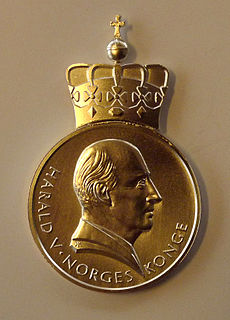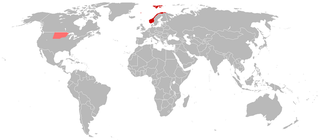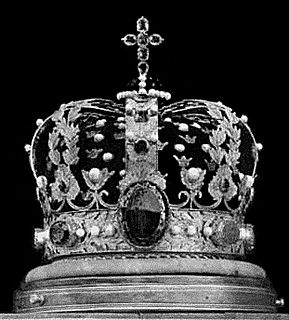
Olav V was King of Norway from 1957 until his death.

Harald V is the King of Norway, having ascended to the throne upon the death of his father King Olav V on 17 January 1991.

Haakon, Crown Prince of Norway is the only son and younger child of King Harald V and Queen Sonja and heir apparent to the throne of Norway.

Princess Astrid, Mrs. Ferner is the second daughter of King Olav V of Norway and his wife, Princess Märtha of Sweden. She is the older sister of King Harald V of Norway and younger sister of the late Princess Ragnhild.

The Order of the Dannebrog is a Danish order of chivalry instituted in 1671 by Christian V. Until 1808, membership in the order was limited to fifty members of noble or royal rank who formed a single class known as White Knights to distinguish them from the Blue Knights who were members of the Order of the Elephant. In 1808, the Order was reformed and divided into four classes. The Grand Commander class is reserved to persons of princely origin. It is only awarded to royalty with close family ties with the Danish Royal House. The statute of the Order was amended in 1951 by a Royal Ordinance so that both men and women could be members of the Order.

The Royal Norwegian Order of Saint Olav is a Norwegian order of chivalry instituted by King Oscar I on August 21, 1847. It is named after King Olav II, known to posterity as St. Olav.
The Union of South Africa King's Medal for Bravery, Gold was the highest South African civilian decoration during the period between 1910 and 1961, when the country was a constitutional monarchy in the British Commonwealth. The medal was instituted by King George VI on 23 June 1939.

The Royal Order of George I is a Greek order instituted by King Constantine I in 1915. Since the monarchy's abolition in 1973, it is considered a dynastic order of the former Greek royal family.

The Norwegian monarch is the monarchical head of state of Norway, which is a constitutional and hereditary monarchy with a parliamentary system. The Norwegian monarchy can trace its line back to the reign of Harald Fairhair and the previous petty kingdoms which were united to form Norway; it has been in unions with both Sweden and Denmark for long periods.

The Medal for Heroic Deeds was instituted by royal resolution on 19 August 1885 and is awarded for honorable actions in saving lives or a comparable act. There was originally three classes, but from 1905 the medal has been awarded in gold and silver. To be awarded in gold the recipient must have committed an unusually notable rescue of life where the rescuer's life was put at risk. The medal is surmounted by the Crown of Norway and the adverse side features the portrait, name and title of the reigning monarch. At present the portrait is of King Harald V of Norway and the inscription reads «Harald den 5, Norges Konge». The reverse features an oak reaf and the words «For edel dåd». The ribbon is in the national colours of Norway: red, white and blue.

The King's Medal of Merit is a Norwegian award. It was instituted in 1908 to reward meritorious achievements in the fields of art, science, business, and public service. It is divided in two classes: gold and silver. The medal in gold is rewarded for extraordinary achievements of importance to the nation and society. The medal in silver may be awarded for lesser achievements. The medal is suspended from a ribbon in the colours of the Royal Standard of Norway.

Haakon VII 70th Anniversary Medal is a Norwegian military award, which was instituted by King Haakon VII of Norway on 27 October 1942. It was awarded in recognition of military personnel who served in the Norwegian armed forces in Britain on the 70th birthday of Norwegian King Haakon VII. The medal ranks 33rd in the Norwegian decoration order of precedence.

The Union of South Africa Queen's Medal for Bravery, Gold was the highest South African civilian decoration during the period from 1952 to 1961, while the country was still a constitutional monarchy in the British Commonwealth. The decoration was instituted by Queen Elizabeth II on 15 December 1952.
The Antarctic Medal is a civil decoration of Norway. Established by King Olav V on 3 February 1960, it was awarded to the individuals associated with the Sixth Norwegian Antarctic Expedition. The medal ranks 27th in the order of precedence of Norwegian honours. The medal ranks below the Maudheim medal, but above H. M. The King's Commemorative Medal in Gold. The medal was awarded to 37 individuals who were part of or associated with Sixth Norwegian Antarctic Expedition.

The Volunteer Long Service Medal was instituted in 1894 as an award for long service by other ranks and some officers of the United Kingdom's Volunteer Force. In 1896, the grant of the medal was extended to other ranks and officers who had served in the ranks of the Volunteer Forces throughout the British Empire. A separate new medal was instituted, the Volunteer Long Service Medal for India and the Colonies. Awarding of this medal was discontinued in stages when it was superseded in most territories by the Colonial Auxiliary Forces Long Service Medal in 1899 and in the remainder by the Efficiency Medal in 1930.
The King Haakon VII 1905–1930 Jubilee Medal, also known as the King's Jubilee Medal, is a Norwegian award instituted in 1930 by Haakon VII of Norway in honor of the 25th anniversary of his accession to the throne. The medal has been conferred upon 397 people.
The King Haakon VII 1905–1955 Jubilee Medal, also known as the King's Jubilee Medal, is a Norwegian award instituted in November 1955 by Haakon VII of Norway in honor of the 50th anniversary of his accession to the throne. The medal ranks 32nd in the Norwegian decoration order of precedence.
The King Haakon VII Commemorative Medal of October 1, 1957 is a Norwegian award created to commemorate the deceased monarch on the occasion of his funeral. King Haakon's funeral took place on October 1, 1957. The medal ranks 30th in the Norwegian decoration order of precedence.
The Royal House Centennial Medal is a Norwegian award established by Harald V of Norway to commemorate the centennial of the Norwegian Royal Family. The day that it was established marks the hundredth anniversary of the day that Haakon VII arrived in Norway: November 25, 1905. The medal ranks 29th in the Norwegian decoration order of precedence.



















